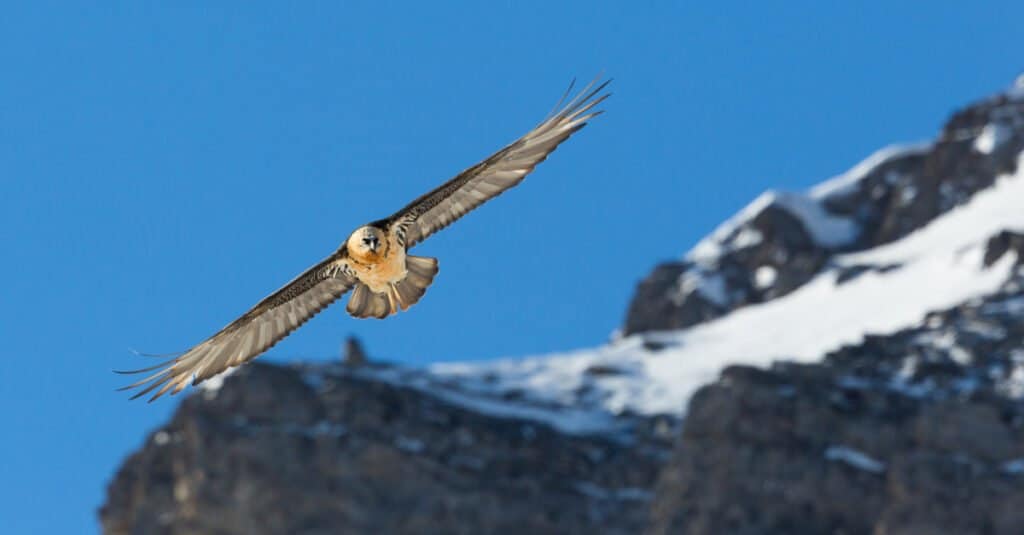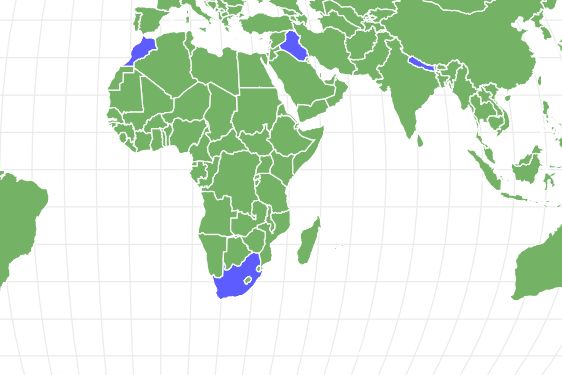Bearded Vulture
Gypaetus barbatus
These birds eat a diet of bones
Advertisement
Bearded Vulture Scientific Classification
- Kingdom
- Animalia
- Phylum
- Chordata
- Class
- Aves
- Order
- Accipitriformes
- Family
- Accipitridae
- Scientific Name
- Gypaetus barbatus
Read our Complete Guide to Classification of Animals.
Bearded Vulture Conservation Status
Bearded Vulture Facts
- Prey
- Tortoises, mammals, birds
- Fun Fact
- These birds eat a diet of bones
- Estimated Population Size
- 1,675-6,700
- Biggest Threat
- Poisoning, power lines
- Most Distinctive Feature
- Black bristly feathers under its bill
- Other Name(s)
- Lammergeier
- Wingspan
- 7.5 feet to 9 feet
- Incubation Period
- 53-60
- Litter Size
- 1-2
- Habitat
- Rocky cliffs, shrublands, forests
- Predators
- Humans
- Diet
- Carnivore
- Average Litter Size
- 1-2
- Type
- bird
- Common Name
- Bearded vulture
- Number Of Species
- 11
- Location
- Asia, Africa, Europe
- Average Clutch Size
- -2
- Nesting Location
- Rocky ledges
- Age of Molting
- 3 months
View all of the Bearded Vulture images!
“Bearded vultures eat the bones of dead animals.”
The bristly black feathers beneath this bird’s bill makes it look like it has a beard. These birds live in a habitat of mountains, forests, and rocky cliffs. They are scavengers with a diet of reptiles, birds, and mammals. The lifespan of this amazing bird in the wild is up to 40 years, but they can live longer in bird sanctuaries and zoos.
3 Bearded Vulture Amazing Facts
- In terms of wingspan and body size, it’s one of the largest vultures in the world
- Its lifespan goes to 40 years and sometimes beyond
- It’s known as a bone eating bird
Where to Find a Bearded Vulture
Bearded vultures live in Europe, Asia, and Africa. They are found in Kenya and Lesotho as well as in various sections of southern Africa. They are found in Spain and France, specifically in the Pyrenees Mountains. China, and India are other places where this bird is found.
These vultures live in a temperate climate. Many create their homes on inland cliffs and in a mountain habitat. So, hiking in the mountains is a great way to spot a vulture colony. The best time to see these vultures is from July to October during their breeding season. They are particularly active building nests and looking for mates.
Bearded Vulture Nests
The outer border of this bird’s nest is made of large sticks, branches, and twigs. The lining is made of wool, hair, feathers, and other soft debris. A nest can measure from three to eight feet in size. They are constructed thousands of feet up on the sides of rocky cliffs and mountains.
As a note, pairs of bearded vultures build a few nests within their particular territory. So, they don’t use the same nest every breeding season.
Bearded Vulture Scientific Name
The scientific name of the bearded vulture is Gypaetus barbatus. The Spanish word Gypaetus refers to this group of Old-World vultures while the word barbatus means bearded.
This bird is also called a lammergeier. Lammergeier is a German word meaning lamb vulture. It earned this name because it eats the bones of sheep and other mammals. Ossifrage is another name of this bird referring to its bone eating behavior.
Its family is Accipitridae, and its class is Aves.
Subspecies of this vulture include:
- Gypaetus barbatus aureus
- Gypaetus barbatus barbatus
- Gypaetus barbatus meridonalis
Bearded Vulture Appearance & Behavior
A bearded vulture has black wings along with a mixture of cream and red feathers on its breast. Its head is cream/yellow, and it has a mask of black feathers as well as black bristly feathers beneath its bill.
This bird’s eyes are rimmed in red with a white eyeball and a black pupil. Its beak is large and curves down into a sharp point at the end. This beak design is what allows a bearded vulture to have a bone eating diet. It uses its sharp talons to grab and hold onto live prey such as a tortoise. It drops the tortoise from a great height in order to break its shell.
When it comes to size, a bearded vulture has a body measuring 37 to 49 inches in length. It weighs 10 to 17 pounds with an incredible wingspan of 7.5 to 9 feet.

The bearded vulture’s wingspan can span up to 9 feet.
©Pascal Halder/Shutterstock.com
Bearded Vulture Diet
Officially, bearded vultures are categorized as carnivores. But they are known for their bone eating behavior. Their diet includes birds, reptiles, and mammals.
What does the bearded vulture eat?
Deer, cows, large birds, and tortoises are all a part of the diet of this animal. Bearded vultures are scavengers, so their main food source is animals that have been killed by other predators.
This vulture uses its bill to break the bones of a dead animal in order to ingest them along with the marrow. Alternatively, pairs of bearded vultures feed dead animal meat to their chicks.
Adult bearded vultures are known to eat live animals as well. For instance, they capture tortoises to eat them. They grab a tortoise in their talons and fly high above a meadow or pasture. The bird drops the tortoise, so its shell cracks apart on the ground. The bearded vulture eats the tortoise’s bones along with some of its meat. In addition, these birds drop large bones from high in the air in order to break them into smaller pieces.
Bearded Vulture Predators, Threats and Conservation Status
What eats bearded vultures?
Humans are the main predators of adult bearded vultures. These birds are sometimes hunted, but for sport instead of for food. In many cases, they die by flying into power lines or eating poisonous meat put out by ranchers to kill other predators.
The eggs and chicks of bearded vultures are vulnerable to predators such as Golden eagleand ravens. But, due to their nesting location high up on cliffsides, they’re fairly well-protected from predators.
Furthermore, bearded vultures are known as fierce protectors of their territory and nest. They’ll corner an intruding bird and viciously flap their wings until the intruder flies away in defeat. Remember, this vulture’s wings are both large in size and powerful enough to injure or kill another bird.
The conservation status of this vulture is Near Threatened along with a decreasing population. Today, there are protected areas where this vulture can reproduce and live in peace.
Bearded Vulture Reproduction, Young, and Molting
Bearded vultures are monogamous birds. Their mating season is from July to October. A female lays one to two eggs, occasionally three. The incubation period lasts 53 to 60 days. During this time, the female sits on the nest and the male protects her and the nest against any threatening birds.
The male and female feed and care for their chicks for at least four months. Most can live independently at four months; however, some young remain near their parents for two years.
View all 285 animals that start with BBearded Vulture FAQs (Frequently Asked Questions)
Do bearded vultures migrate?
Bearded vultures don’t migrate.
How many eggs does a bearded vulture lay?
These vultures have one to two eggs in a clutch.
How fast does a bearded vulture fly?
These birds fly at a speed of 40 mph.
What is the bearded vulture’s wingspan?
The bird’s wingspan is 7.5 to 9 feet.
When do bearded vultures leave the nest?
Most can leave the nest and live independently at four months of age. But some of the young are cared for by their parents for closer to two years.
What do bearded vultures eat?
They are carnivores with a diet including deer, cows, tortoises, large birds and more. Bearded vultures are scavengers eating carrion.
Why do bearded vultures eat bones?
The bones they eat are high in fat. This bone-eating behavior gives these birds a tremendous supply of energy. So, once they find carrion in a field or meadow, they can get as many nutrients out of it as possible.
The acid in this bird’s stomach allows it to digest bones within 24 hours.
Is the bearded vulture an eagle?
Though they belong to the same family, they are not the same bird.
Are bearded vultures friendly?
Bearded vultures are not aggressive unless they are defending their territory or nest. However, they are wary of humans. If a human approached one, the bird would likely fly away unless it felt its territory or young were being threatened.
Thank you for reading! Have some feedback for us? Contact the AZ Animals editorial team.
Sources
- , Available here: https://4vultures.org/blog/possibly-the-highest-bearded-vulture-nest-at-almost-5000-metres-altitude-discovered-in-the-himalayas/
- , Available here: https://www.zoo-berlin.de/en/artenschutz/weltweit/bearded-vulture
- , Available here: https://en.wikipedia.org/wiki/Bearded_vulture
- , Available here: https://www.iucnredlist.org/species/22695174/154813652
- , Available here: http://africanraptor.co.za/gallery/bearded-vulture-2/
- , Available here: https://tibetpedia.com/lifestyle/the-lammergeier/
- , Available here: https://faunafocus.com/portfolio/bearded-vulture/

















